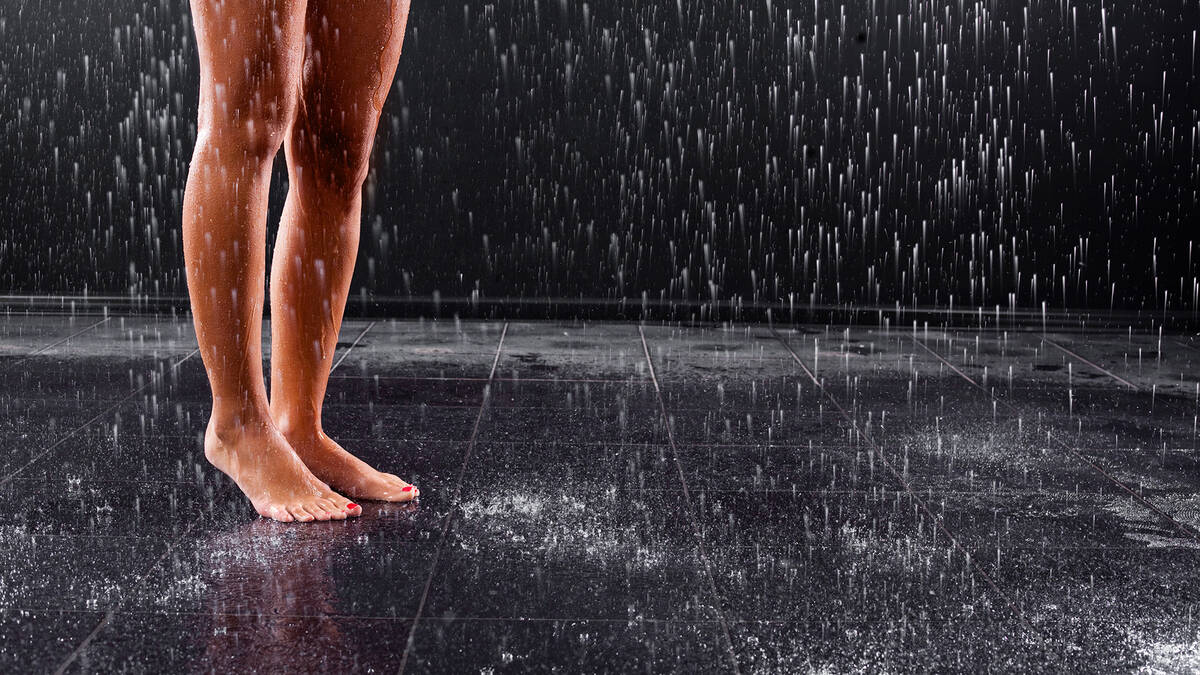Safe showering with the right flooring
Nonslip tiles for more safety in the bathroom
Caution: Slip hazard! The surface of wet floors can turn into a serious source of danger. Slip-resistant tiles mitigate this danger without compromising design or functionality. We present suitable models in attractive designs for the bathroom and explain what slip resistance classes mean – so you and your loved ones have a firm footing at all times.

These tiles are a firm place to stand on
People of all ages can easily slip and fall on a wet floor. Injuries, minor and serious, in the bathroom are part of everyday life in Germany. One example: Roughly 250,000 people are injured in this room every year in Germany alone. Bruises and broken bones, mostly in the arms and hands, are the result.
Non-slip models greatly increase safety in the bathroom due to their rough surface. You can get them in numerous materials that fit any style of interior.
Choose from the following models with slip-resistant features:

- Premium stone look: Porcelain stoneware inspires with its natural look, deceptively imitating natural stone. These ceramic tiles are fired at extremely high temperatures and are particularly durable. Unglazed tiles have a rough surface that prevents slipping, while glazed ones with a natural stone look are given an additional layer of irregularly textured glass, which also has an anti-slip effect.
- Stylish concrete look: Give a room that coveted industrial look, making them ideal for fans of minimalist design. Like stone-look tiles, they are made of sturdy porcelain stoneware. Their uneven structure automatically creates steady footing.
- Unusual wood look: Besides natural stone and concrete, porcelain stoneware also makes an amazing imitation of wood. The wood grain created in this way makes the upper surface uneven, and thus safe to step on. This floor perfectly complements elements of real wood in your bathroom.
- Eye-catching decor: Tiles with ornaments set beautiful accents and loosen up the room. If a patterned floor is too much for you, how about a border or a decorative island surrounded by matching, monochrome tiles?
- Structural patterns: These ceramic floors impress not only with colorful ornaments, but with relief-like designs on their surface. The bumps, combined with rough glazing, provide slip resistance.
- Small mosaic tiles for creative freedom: With their small dimensions, these floors automatically provide slip-resistant properties. Their edge length is between two and ten centimeters. The smaller the length, the more joints provide grip. In addition, they usually have a textured surface. You can get mosaic tiles in a wide variety of colors, allowing for all kinds of design – from ornaments to color gradients.
The different slip resistance classes and their meaning
Tiles are divided into slip resistance classes ranging from R9 to R13. The class tells what inclination angle is safe for a tile covered with oil. The degrees indicate how great the inclination angle can be for safe walking and standing. These classes apply to commercially used rooms, but can also give you private orientation for your bathroom design.
- R9: These models only have low slip resistance. The safe inclination angle is between six and ten degrees. They are suitable for dry spaces like living rooms and bedrooms.
- R10: This medium slip resistance is considered safe for all surfaces that have to withstand high humidity, such as kitchens, bathrooms, or garages. The maximum inclination angle for safe movement is ten to 19 degrees.
- R11: This safety class is recommended for outdoor areas such as terraces and stairs. Here, the safe inclination angle is between 19 and 27 degrees.
- R12/R13: For spaces with a very high risk of slipping, including swimming pools and saunas, we recommend choosing these two slip resistance classes. For R12, the inclination angle is between 27 and 35 degrees, and for R13, it’s above 35 degrees.
In a private bathroom, class R10 is usually sufficient. You can play it safe in floor-level showers with class R11.
In addition to these classes, there are also the designations A, B, and C. They describe the slip resistance in barefoot areas. A, B, and C indicate how slip-resistant the tile is when covered with water. A is for models that occasionally get wet, such as in a locker room. The B designation is given to models that frequently have a wet surface, such as the spaces surrounding swimming pools or the floors in shower rooms. Permanently wet tiles, such as in a swimming pool, are given the letter C.
Anti-slip tiles for safe footing
A damp or wet bathroom floor can be a hazard for anyone. With anti-slip floors, you can prevent accidents without sacrificing attractive design. You can get slip-resistant tiles in numerous varieties to match any style. Classes R9 to R13 indicate the extent to which a slippery surface allows safe movement at an incline.
Frequently asked questions about tiles with slip-resistant surfaces
Stoneware tiles with a slip-resistant structure are available in different variants. They can almost perfectly imitate the look of natural stone, concrete, and wood grains.
Unlike colored ornaments, these patterns are characterized by relief-like surfaces, giving feet something to grip on to.
The small dimensions require numerous joints that provide stability to stand on. In addition, the surface is usually textured.
Normally, Class R10 is sufficient. In frequently wet areas like a floor-level shower, we recommend R11.
They indicate the slip resistance in barefoot areas, where A means low slip resistance and C means high slip resistance.
Trusted partners